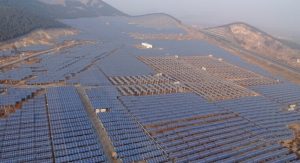Vol. 18 #7 October 29, 2017: Electricity Insurance and the Grid
In This Issue
Flanigan’s Eco-Logic
World’s Largest Rooftop Solar Installation
Net Positive Bhutan and Gross Happiness
Four Countries Lead on Carbon Neutrality
Plans for the World’s Largest Solar Plant
Campus Sustainability
The Dutch Reach
Renewables Rock on Worldwide!
EcoMotion’s Podcast

Flanigan’s Eco-Logic: Electricity Insurance and the Grid
Recently I was asked to speak at a conference of lawyers. My topic is “disruptive technologies in the power sector.” Sounds bad doesn’t it? What good comes out of disruptions? Nasty things like renewable systems and now batteries that threaten utilities’ profits. These, like Uber and AirBNB, are disrupting business as usual for utilities. They are nuisances… and they are not going away.
Disruptive technologies are fueled by innovations and technology advances. Solar systems are now often cost-effective alternatives to buying grid power. If you use a lot of peak power, batteries and other storage systems are starting to pencil. These disrupt the normal way of doing business and in turn offer viable alternatives. Ride the wave!
Perhaps sooner than we expect, we will value and buy electricity insurance. What? Yes, insurance, that in the event that one’s own household electricity system is down, you can buy from the grid. Just like owning a roof in Southern California – that only gets used and proves its worth periodically – you will only call on the grid periodically…when all else fails!
Perhaps someday, central stations, major power transmission and distribution networks will themselves be the “disruptive technologies.” They disrupt views, they threaten beaches and our well-being, and they require major corridors through our forests and parks. In some cases, central systems disrupt our national security. While we have come to accept them, we may well love life better without them. Consider the prize real estate commanded by power plants! Consider the views terribly impacted by transmission lines! Think no more strip mines or offshore oil.
Micro-grids and islanding are the rage today. Some countries, like Tanzania are working to develop micro-grids in remote villages. They make sense given new technologies. They present new ways of looking at power systems by using renewables not as icing on the cake, but instead as base-load production. Micro-grids are in favor, but ideally, I’d argue, that the grid we have today is a fantastic insurance policy. Insurance is well worth its cost. Insurance is about peace of mind and in this case, power when you need it most.
But let’s get real. Utilities will not want to get dimes on the dollar of their current revenue stream. Serving as the back-up insurance underwriter instead of the seller – sounds like a big step down! I suspect it is. So utilities have to get in the distributed generation and storage game. They need to own the means of production, be it household and/or community based. Since innovations and new technologies make distributed energy resources viable, smart utilities will serve this market and secondary insurance markets. Smart utilities – present or future – will own the business!




 Four countries are competing to be the first of the world’s 195 nations to go entirely carbon neutral. They are diverse indeed but bonded in carbon neutrality. They made their bold declarations in Monaco at the annual meeting of the Governing Council of the United Nations Environment Program. Iceland, New Zealand, Norway and Costa Rica formally signed up to go zero carbon.
Four countries are competing to be the first of the world’s 195 nations to go entirely carbon neutral. They are diverse indeed but bonded in carbon neutrality. They made their bold declarations in Monaco at the annual meeting of the Governing Council of the United Nations Environment Program. Iceland, New Zealand, Norway and Costa Rica formally signed up to go zero carbon.

 The 2016 Sustainable Campus Index, a publication by the Association for the Advancement of Sustainability in Higher Education (AASHE), recognizes top-performing colleges and universities overall and in 17 distinct aspects of sustainability, as measured by the Sustainability Tracking, Assessment & Rating System (STARS).
The 2016 Sustainable Campus Index, a publication by the Association for the Advancement of Sustainability in Higher Education (AASHE), recognizes top-performing colleges and universities overall and in 17 distinct aspects of sustainability, as measured by the Sustainability Tracking, Assessment & Rating System (STARS). Nearly every cyclist has had to quickly swerve out of the way to avoid drivers opening their car doors. My cousin Elizabeth just had a horrific accident in Bethesda, Maryland, sending her into surgery for a broken hip. Opening car doors into bike lanes is dangerous; there’s even a term for it: “dooring.” Getting “doored” recently
Nearly every cyclist has had to quickly swerve out of the way to avoid drivers opening their car doors. My cousin Elizabeth just had a horrific accident in Bethesda, Maryland, sending her into surgery for a broken hip. Opening car doors into bike lanes is dangerous; there’s even a term for it: “dooring.” Getting “doored” recently 
 We have a podcast called EcoMotion Conversations!
We have a podcast called EcoMotion Conversations!